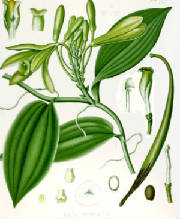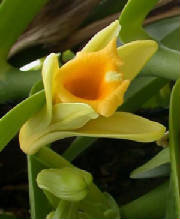| Vanilla Plant |

|
| Vanilla Flower |

|
Scientific Name: Vanilla planifolia aka Vanilla fragrans
Family: ORCHIDACEAE. Common Name: Vanilla.
It is a tropical climber with a thick, succulent and green stem bearing adventives roots. The leaves are oblong with
parallel veins, thick, smooth, bright green leaves about 20 cm long. The greenish flowers are composed of 3 similar sepals
and 3 petals similar to the sepals but shorter. It has a very short-lived blooming period. The fruits are in the form of
pods 12 to 22 cm long, light green, and almost cylindrical.
It was originated from the Totonaca people of Mexico. Now, Madagascar and Indonesia produce the majority of the world
vanilla. Other countries such as Tahiti, Madagascar, Comoros, Reunion Island, Tong also grow them. It strives well in humid
tropical climates. The Vanilla plant produces pods in its 3 th and 4 th year; however the harvesting is normally done once
a year in September.
The Vanilla pod is harvested before it is ripe. The pods are first scalded in warm water or dry heated to halt the ripening
process and prevent them from cracking. Then, they are fermented in order to develop their aroma. The initial gluco-vanillin
and vanillic substances give rise to vanilla and the corresponding vanilla alcohol. Finally, the pods are dried either in
the sun or in ovens, giving them their waxy, and at times frosted aspect of vanilla crystals. The pods can be used as is.
Its flavors can also be extracted using volatile solvents. Today natural vanilla is challenged by artificial vanilla.
It has a sweet odor. It is widely sued in perfumery as a fixative and as a base.
|
|
|

